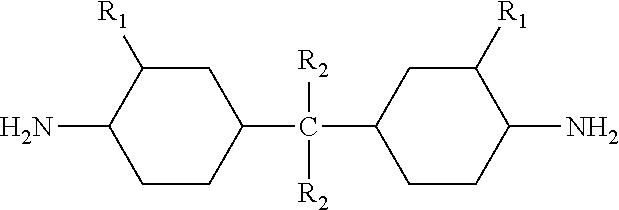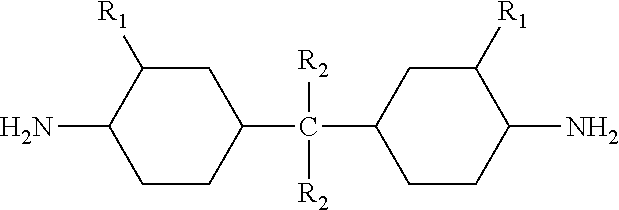Composite material with polyamide particles
a technology of polyamide particles and composite materials, applied in the direction of weight reduction, etc., can solve the problems of reducing damage tolerance, reducing damage tolerance, and affecting the quality of composite materials, so as to achieve high strength, damage tolerance and interlaminar fracture toughness
- Summary
- Abstract
- Description
- Claims
- Application Information
AI Technical Summary
Benefits of technology
Problems solved by technology
Method used
Image
Examples
example 1
[0069]A preferred exemplary resin formulation in accordance with the present invention is set forth in TABLE 1. A matrix resin was prepared by mixing the epoxy ingredients at room temperature with the polyethersulfone to form a resin blend that was heated to 130° C. for 60 minutes to completely dissolve the polyethersulfone. The mixture was cooled to 80° C. and the rest of the ingredients added and mixed in thoroughly.
TABLE 1IngredientAmount (Wt %)Bisphenol-F diglycidyl ether (LY9703)22.5Trifunctional para-glycidyl amine (MY0510)22.5Aromatic diamine curing agent (3,3-DDS)19.6Thermoplastic Toughening Agent (HRI-123.4polyether sulfone)Polyamide particles (25 microns) that are a12.0polymeric condensation product of 3,3′-dimethyl-bis(4-aminocyclohexyl)methane and1,10-decane dicarboxylic acid (GRILAMIDTR90)
[0070]Exemplary prepreg was prepared by impregnating one or more layers of unidirectional carbon fibers with the resin formulation of TABLE 1. The unidirectional carbon fibers (IM7 ava...
example 2
[0079]Additional exemplary prepregs were prepared in the same manner as Example 1, except that the fiber reinforcement was IM10. IM10 is a unidirectional carbon fiber material which is also available from Hexcel Corporation (Dublin, Calif.). The exemplary matrix formulations are set forth in TABLE 3. The exemplary prepregs included matrix resin in an amount of 35 weight percent of the total uncured prepreg weight and the fiber areal weight of the IM10 fiber was 145 grams per square meter (gsm). SP 10L are PA12 polyamide particles) that are available commercially from Toray Industries (Japan).
TABLE 32A2BIngredient(wt %)(wt %)GY28517.016.6MY060025.725.1MY72110.310.1PES 5003P18.718.7TR90 (25 microns)4.756.75SP10L6.256.253,3-DDS20.620.1
[0080]The cured exemplary prepregs were subjected to the same testing procedures as in Example 1. The results are set forth in TABLE 4.
TABLE 42A2BCAI57.659.2G1c2.32.2G2c12.23.00° Comp. Strength280271(RT / dry)0° Comp. Strength187187(180° C. / wet)
[0081]Exampl...
PUM
| Property | Measurement | Unit |
|---|---|---|
| temperature | aaaaa | aaaaa |
| thickness | aaaaa | aaaaa |
| wt % | aaaaa | aaaaa |
Abstract
Description
Claims
Application Information
 Login to View More
Login to View More - R&D
- Intellectual Property
- Life Sciences
- Materials
- Tech Scout
- Unparalleled Data Quality
- Higher Quality Content
- 60% Fewer Hallucinations
Browse by: Latest US Patents, China's latest patents, Technical Efficacy Thesaurus, Application Domain, Technology Topic, Popular Technical Reports.
© 2025 PatSnap. All rights reserved.Legal|Privacy policy|Modern Slavery Act Transparency Statement|Sitemap|About US| Contact US: help@patsnap.com



